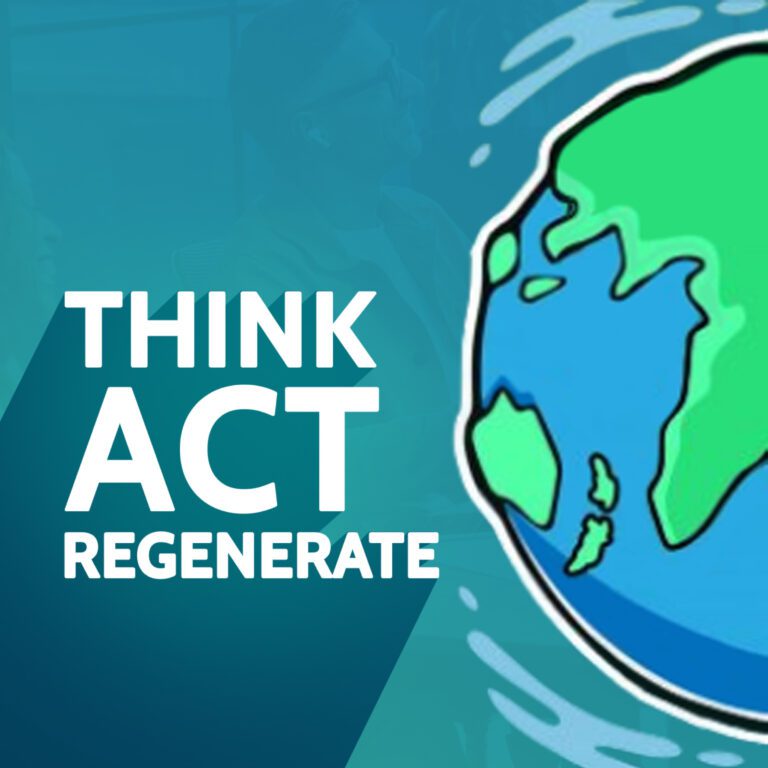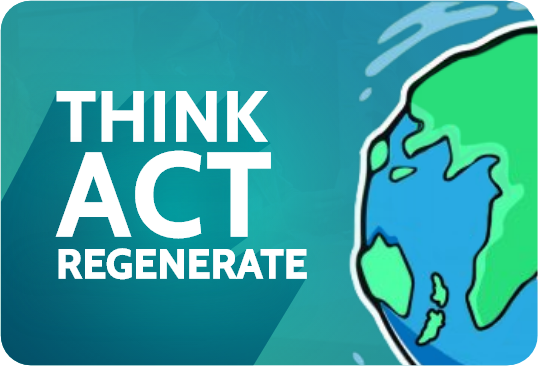
THINK ACT REGENERATE is a podcast by Leigh Baker of ThinkActRegenerate which explores the wealth of regenerative design solutions happening on the ground in Australia and New Zealand, as well as around the world.
One of the core propositions of Think Act Regenerate is that today’s regenerative design thinking enables a rich smorgasbord of smarter, faster, funner win/win/win solutions that go WAY beyond 20th century “sustainability” and “efficiency”.
What IS regenerative thinking?
To me, it’s a new place to stand – because we can’t solve 20th century problems with 20th century thinking.
Here’s my take on what regeneration is about and why it has a strong business focus, illustrated with a heap of examples.
FULL TEXT:https://thinkactregenerate.com/insight-levelling-up-to-design-for-regeneration/#text
LINKS
Think Act Regenerate INSIGHTS email series: http://thinkactregenerate.com/insights
Think Act Regenerate INSIGHT on OPPORTUNITY https://thinkactregenerate.com/insight-a-world-of-business-and-career-opportunity/
Books and general links
BUSINESS LESSONS FROM A RADICAL INDUSTRIALIST https://us.macmillan.com/books/9781429997164/businesslessonsfromaradicalindustrialist
REGENERATION: https://regeneration.org/the-book
THE DEEP GREEN PROFIT HANDBOOK https://thinkactregenerate.com/wp-content/uploads/2023/11/DeepGreenProfit.pdf
Michael Porter: “Why business can be good at solving social problems” https://www.ted.com/talks/michael_porter_why_business_can_be_good_at_solving_social_problems.html
Project Drawdown: https://drawdown.org/solutions
Examples:
Precious metals being recovered from ewaste using the whey https://rpra.ca/the-hub/researchers-extract-gold-from-e-waste-using-a-cheese-byproduct/
Farmer upcycling excess produce https://thinkactregenerate.com/dried-bananas-food-vodka/
AMP upcycling skyscraper https://thinkactregenerate.com/upcycling-commercial-buildings-circular-economy-at-a-whole-new-scale/
Sundrop farms, using solar energy and seawater to grow tomatoes in the desert: https://www.sundropfarms.com/
Interface flooring, utilising land-fill methane to power a factory https://www.greenbiz.com/article/interface-flooring-powers-plant-using-landfill-emissions
Farmers installing solar panels to protect their crops and power their on-farm equipment
https://ceat.org.au/the-benefits-of-agrivoltaics-in-agriculture/
A Riverina renewable energy coop building a community solar garden https://switchedon.reneweconomy.com.au/content/australias-first-community-solar-garden-becomes-a-reality
Kua Coffee, utilising a social enterprise structure to serve its growers in Kenya https://kuacoffee.co/learn/why-does-kua-have-a-foundation-and-a-company
An Indian company making a vegetable-based “Leather” from banana waste: https://banofileather.com/
Plastic-free coffee pods utilising algae-based material to protect the coffee https://www.fastcompany.com/91056402/how-keurig-finally-made-a-coffee-pod-with-no-plastic
Waste processing powered by Black Soldier Fly for food waste: https://goterra.au/food-waste-management/
HarperCollins use design to reduce paper cost and save trees https://www.fastcompany.com/91071102/harper-collins-made-a-tiny-tweak-to-its-book-design-and-has-saved-thousands-of-trees-as-a-result
Totally Renewable Yackandandah – from solar panels to energy retailer https://totallyrenewableyack.org.au/
Melbourne business turns toner cartridge waste into road
surfacing material and vegetable garden modules: https://roadsonline.com.au/the-proof-is-in-the-pavement-with-close-the-loop/
WA farmer is using biochar and dung beetles to reduce operating costs, increase production :
https://www.wantfa.com.au/wp-content/uploads/2016/04/WANTFA_NF_Summer2015_Biochar-002.pdf
A family-run building company in NSW building super-efficient housing that sells itself https://thefifthestate.com.au/columns/news-from-the-front-desk/news-from-the-front-desk-issue-no-231/

One of the core propositions of Think Act Regenerate is that today’s regenerative design thinking enables a rich smorgasbord of smarter, faster, funner win/win/win solutions that go WAY beyond 20th century “sustainability” and “efficiency”.
What IS regenerative thinking?
To me, it’s a new place to stand – because we can’t solve 20th century problems with 20th century thinking.
Here’s my take on what regeneration is about and why it has a strong business focus, illustrated with a heap of examples.
LINKS
Think Act Regenerate INSIGHTS email series: https://thinkactregenerate.com/insights
Think Act Regenerate INSIGHT on OPPORTUNITY https://thinkactregenerate.com/insight-a-world-of-business-and-career-opportunity/
Books and general links
BUSINESS LESSONS FROM A RADICAL INDUSTRIALIST https://us.macmillan.com/books/9781429997164/businesslessonsfromaradicalindustrialist
REGENERATION: https://regeneration.org/the-book
THE DEEP GREEN PROFIT HANDBOOK https://thinkactregenerate.com/wp-content/uploads/2023/11/DeepGreenProfit.pdf
Michael Porter: “Why business can be good at solving social problems” https://www.ted.com/talks/michael_porter_why_business_can_be_good_at_solving_social_problems.html
Project Drawdown: https://drawdown.org/solutions
Examples
Precious metals being recovered from ewaste using the whey https://rpra.ca/the-hub/researchers-extract-gold-from-e-waste-using-a-cheese-byproduct/
Farmer upcycling excess produce https://thinkactregenerate.com/dried-bananas-food-vodka/
AMP upcycling skyscraper https://thinkactregenerate.com/upcycling-commercial-buildings-circular-economy-at-a-whole-new-scale/ Sundrop farms, using solar energy and seawater to grow tomatoes in the desert: https://www.sundropfarms.com/
Interface flooring, utilising land-fill methane to power a factory https://www.greenbiz.com/article/interface-flooring-powers-plant-using-landfill-emissions
Farmers installing solar panels to protect their crops and power their on-farm equipment https://ceat.org.au/the-benefits-of-agrivoltaics-in-agriculture/
A Riverina renewable energy coop building a community solar garden https://switchedon.reneweconomy.com.au/content/australias-first-community-solar-garden-becomes-a-reality Kua Coffee, utilising a social enterprise structure to serve its growers in Kenya https://kuacoffee.co/learn/why-does-kua-have-a-foundation-and-a-company
An Indian company making a vegetable-based “Leather” from banana waste: https://banofileather.com/
Plastic-free coffee pods utilising algae-based material to protect the coffee https://www.fastcompany.com/91056402/how-keurig-finally-made-a-coffee-pod-with-no-plastic
Waste processing powered by Black Soldier Fly for food waste: https://goterra.au/food-waste-management/
HarperCollins use design to reduce paper cost and save trees https://www.fastcompany.com/91071102/harper-collins-made-a-tiny-tweak-to-its-book-design-and-has-saved-thousands-of-trees-as-a-result
Totally Renewable Yackandandah – from solar panels to energy retailer https://totallyrenewableyack.org.au/
Melbourne business turns toner cartridge waste into road surfacing material and vegetable garden modules: https://roadsonline.com.au/the-proof-is-in-the-pavement-with-close-the-loop/
WA farmer is using biochar and dung beetles to reduce operating costs, increase production :
https://www.wantfa.com.au/wp-content/uploads/2016/04/WANTFA_NF_Summer2015_Biochar-002.pdf A family-run building company in NSW building super-efficient housing that sells itself https://thefifthestate.com.au/columns/news-from-the-front-desk/news-from-the-front-desk-issue-no-231/
CREDITS
Original music composed for the show by Ian Hopkinson of HopkinsonCreative.com – used with permission.
TRANSCRIPT
Regeneration designs for benefits today – benefits that increase the ability of communities, ecosystems, and organisations to thrive today and into the future.
Leigh Baker
Hello there. I’m Leigh Baker, your host for this episode of the Think Act Regenerate podcast, where we explore the myriad ways that thinking more broadly about today’s challenges is enabling deeper, more informed action today and delivering smarter solutions today.
This podcast episode was recorded and produced on Wurundjeri lands to the east of Melbourne Australia.
In this and several coming episodes, I’m exploring some key mindset shifts that I’ve seen you evolving over the last two decades. I call these shifts insights – because insight is what I’ve developed as I’ve worked to understand and apply them.
These insights started life back in 2009, when I distilled my first seven years of exploring regenerative business and the supply chain into a 90 page book called THE DEEP GREEN PROFIT HANDBOOK.
I then put together a short, free email series explaining the 10 insights that I find most useful. There’s a link to that email series in the show notes. Now I’m summarising those 10 insight emails into episodes of this podcast.
The first insight, which I covered in a previous episode, is about a fundamental shift to OPPORTUNITY thinking.
This episode is around the second insight – the gradual shift that I’ve observed business innovators making from extractive design to regenerative design.
Following on from these two episodes, I’ll be talking about four supply chain shifts and four key implementation trends that are being used to deploy regenerative design and regenerative business into the real world today.
Do keep in mind. that this is my interpretation. I see it as a fundamental design shift from extractive thinking to regenerative thinking. It is informed by many thought leaders: Bill McDonough, Janine Benyus, Paul Hawken, Ellen Macarthur. Bill Reed, Donella Meadows. There are too many to name.
So what is regenerative design and why does it matter?
[00:03:00] Briefly, regenerative design is an approach that sets the goal of designing and redesigning the products and the services and the systems that we use every day, so they deliver benefits to natural systems and human communities, as well as economic value And in fact turning that whole equation around.
A regenerative mindset broadens the scope and lifts the outcomes of the design process beyond 20th century mindsets. It sets the objective that the products, systems and services, which we use every day should be purposely designed to generate economic prosperity BY regenerating natural ecosystems and regenerating human communities.
And what doesn’t make the mainstream media very often is that we can do this today using the solutions that we have today to solve the challenges that we face today.
To me, this is important because it provides that thing that truly motivates human creativity. It’s a positive goal. It aims for positive outcomes without assuming some sort of win-lose trade-off.
Not only is it a positive goal, aiming for positive outcomes – its focus is now and here; locally, immediately. It creates opportunity, it creates possibility – and that can be enormously powerful.
Regenerative thinking opens up access several fundamental human desires at the same time.
Our desire to avoid short term loss, because we’re playing a win-win game. Our desire to avoid suffering and scarcity – because if we can make today better and tomorrow better at the same time, we may have to work, but we don’t have to suffer.
It leverages our desire to avoid missing out on opportunities. It leverages our desire for personal and community benefits., and our desire to make a positive impact.
Regenerative design accesses our desire to create and build, our desire to be part of a tribe. Regenerative design offers influence and impact today to those prepared to explore for their opportunities today.
Regenerative thinking and regenerative design have led to the commercialisation of a wealth of solutions.
And with commercial solutions in the marketplace, regenerative design is increasingly becoming a rich source of business innovation and growth, a rich source of career opportunity, a rich source of community development opportunity.
It’s a strategy you can start working on today to make your bit of the world a bit better. And possibly a lot better, starting today.
[00:06:00] A regenerative mindset takes design to an exciting, rewarding new level.
Its objectives are challenging. It’s not necessarily easy -inside our current industrial mindset to design products, systems, and services that generate economic prosperity by regenerating ecosystems and communities. It can be done today because we already have the technology and we have a myriad of case studies.
The challenge is not an invention challenge. The challenge is accelerating the adoption of the solutions we already have.
Adopting a regenerative mindset makes regeneration a business deliverable and a business opportunity and a whole lot of fun.
Regeneration goes beyond reducing harm and reducing your negative impact where you think it’s affordable in the short term. Regeneration goes beyond “sustaining what we have today for the sake of tomorrow”.
Regeneration involves innovating systems rather than products and processes. Business systems, government systems and supply chain systems. Evolving those systems so they actively restore renew and revitalise their host ecosystems and communities.
Regeneration views today’s problems as opportunities: Commercial opportunities for business innovation. Personal opportunities for career development and social opportunities for community development.
What do you need to start doing regeneration?
You didn’t need to understand the internal combustion engine before you started driving a car but you did need to understand the instrument panel and the road rules.
You don’t need a master’s in environmental science or business to get started. The first step is to explore the regeneration worldview.
Why explore a worldview? World view shifts solve problems and drive innovation.
Think of the worldview shift that upgraded astronomy in the 16th century. It was a shift to a more accurate understanding of the place of the human species in the universe. That shift in astronomy happened when observers like Galileo, Copernicus, and Kepler started to consider some new ideas.
The idea that the earth wasn’t the centre of the universe. The idea that planets moved in elliptical orbits, not perfect circles. The idea that the sun was the centre of the solar system. And the idea that our solar system was just a tiny piece in a whole universe of solar systems.
[00:09:00] That world view shift – which started in astronomy – didn’t just make doing the maths of astronomy easier, it also drove and leveraged technology innovations like telescopes and printing presses. That world view shift, was foundational in the further development of physics and became an early building block towards the industrial revolution.
That 16th century mindset shift – a bit like today’s regenerative shift – took time to spread. And its advocates experienced substantial human systems resistance from the incumbent status quo. (Some of them got burned at the stake by the church and its inquisition.)
But over time that mindset shift took hold. Why? Because it worked better!
Today, the mindset of regeneration puts business in a new perspective. It puts human industry explicitly and purposefully in the context of its long-term dependence on the well being of the ecosystems and the community it operates within.
Regeneration challenges several 20th century assumptions about business and its place in the world
Regeneration challenges the hypothesis that business somehow exists in an alternate universe that is independent of its host ecosystems and communities.
Regeneration challenges the hypothesis that ecosystems and communities are infinite capacity, eternal sources of low cost resources.
Regeneration also challenges the hypothesis that government and charity are the primary players responsible for ecosystem and community well being.
And regeneration challenges the hypothesis that we must necessarily reduce and suffer today in order to do less harm tomorrow.
Ultimately regenerative business – with its wealth of solutions and benefits – challenges the hypothesis that going forward, extractive business design must be permanently and inevitably cheaper and more efficient than any other alternative.
The regenerative worldview designs for benefits today, benefits that increase the ability of communities, ecosystems, and organisations to thrive today and into the future.
The result?
Today’s regenerative mindsets level up the game of business design. They level up the game of product design. And they level up the games of systems design, supply chain, design, and process design, taking those games to a whole new level of innovation of creativity and positive impact.
[00:12:00] While regenerative design can seem like a recent, temporary, idealistic fad, the technology supporting it has been evolving for a long time – elements of it for centuries.
Solar panel development actually started back in the 1880s. Electric vehicles were being sold in the 1890s.
Living building design draws on ancient building techniques as well as modern technology.
Regenerative agriculture’s biochar practice has been happening in the Amazon for over 1500 years.
And – in the same way that better astronomy supported better science, physics and engineering – today’s regenerative design principles and practices off a qualitatively better production solutions, solutions that go beyond the limitations of 20th century one way supply chains with their high energy mechanical and chemical engineering technologies.
There are some key systems design approaches that support today’s regenerative business implementations
I’ll be covering them in more detail in future episodes, so if you’re interested then follow this series on your favourite platform.
One regenerative design approach that’s getting a lot of traction is a non-polluting super efficient solution set of biomimicry.
Briefly, biomimicry applies physics and biology and ecosystem models to design non-toxic renewably powered systems, products, and processes. Biomimicry leverages nature’s 3.8 billion years of delivering solutions at room temperature using renewable resources and renewable energy.
What does this look like? It looks like packaging grown from fungus fed on farm waste, creating materials that can replace everything from polystyrene and cardboard to insulation panels.
It looks like super efficient wind turbine designs informed by the wing tips of South American eagles. It looks like aircraft cabin partitions designed based on the structure of your bones and 3D printed.
Regenerative design also leverages the full spectrum of circular economy design principles.
Full spectrum circular economy goes way beyond “after thought” recycling approaches that it’s often confused with.
Instead, it intentionally designs systems that circulate resources continuously – without the constant overhead of ongoing high-impact, high energy, extraction and refinement and transportation of non-renewable virgin resources.
What are some results of full-spectrum circular economy?
Precious metals being recovered from e-waste using the liquid whey [00:15:00] leftover from cheese making.
An Australian farming couple upcycling excess bananas and sweet potatoes into gluten-free flour and vodka.
It looks like the insurance giant AMP upcycling a whole Sydney skyscraper for less cost and with more efficiency then the more common demolish and build new approach.
Regenerative design leverages renewable energy solutions that offer clean power. Power without the ongoing health costs of cancer and asthma. Power without the environmental costs of oil spills, farmland fracking, and acid rain.
Power without the inbuilt supply chain inefficiency of constantly extracting fossil fuels and endlessly paying their substantial and ongoing transport, processing and storage overheads.
So, what does this look like?
One example is Sundrop farms in south Australia using solar energy and sea water to grow tomatoes in the Outback and distribute them through Coles.
It looks like interface flooring using landfill methane to power a carpet factory, an innovation that reduced community landfill costs and delivered cleaner air as well as clean energy to their manufacturing plant.
It looks like Korean farmers installing solar panels to protect their crops from solar peaks and to power their on farm equipment, reducing their costs and improving their productivity.
Regenerative design is also evolving a range of new organisation and financial structures for delivering value to multiple stakeholders. It’s building social enterprises and operating beneficial corporations – organisations that are empowered to deliver on multiple goals and to deliver positive results to multiple stakeholders.
These new enterprises go beyond the simplistic goal Of short-term profits limited to shareholder wallets and executive pay packets- profits made through social and environmental extraction.
Regenerative business is leveraging the latest in finance technology from crowdfunding and micro finance and FinTech.
The results?
A renewable energy co-operative in Australia’s Riverina, building a community solar garden that enables renters to access clean energy.
You get an Australian coffee, roaster and distributor called Kua coffee, utilising a social enterprise structure to retain profits so they can grow their ethical climate, positive coffee business. A business that provides community run development support to the Kenyan farmers who supply their coffee.
[00:18:00] A larger scale? You get Patagonia’s founders transferring ownership of their billion dollar business to a specially designed trust and nonprofit structure. One structured to protect ecosystems and prevent their destruction.
These enhanced financial and business structures enable for-purpose businesses today to serve all their stakeholders.
Regenerative business creates opportunities today to make the world better today, and to create sustainable, ongoing value in doing so.
Purposeful integrated, authentic business structures designed for the long term have multiple benefits to organisations.
They increase the engagement levels of their employees, customers, suppliers, and communities. They unleash innovation and increase involvement as their people realise the capacity of their work to change the world today.
Regenerative business lifts the business innovation and development bar
It challenges to designers and engineers and operations people at all levels to design, build, deliver, and operate products, systems, and services that increase the capacity of ecosystems and communities to flourish and prosper and to support the continued prosperity of business.
Regenerative business is inspiring designers, engineers, intrapreneurs and entrepreneurs to a whole new level of creativity and innovation – innovations founded on the principle that business is actually a wholly owned subsidiary of the ecosystems and communities that it cannot exist without.
Like many things that are possible in the early stages, possible and commercial does not mean easy. Regeneration requires new technologies and ancient wisdom, new design thinking and new services.
While there is a growing range of commercial regenerative solutions today, the self conserving nature of human systems makes global adoption a major challenge. Not least because many solutions are not in line with what “everyone knows”. And resistance from those who benefit from the current status quo is, unsurprisingly, substantial.
The shift to regeneration also demands that most anxiety producing of human experiences – change.
Fortunately, a small but significant percentage of the human race finds long term intentional sustained effort towards smarter solutions and positive goals, extremely rewarding. For some it’s Olympic gold.
[00:21:00] For others, it could be artistic creation or making a garden. And for some, it’s building or participating in a regenerative enterprise.
Being possible may not be enough
We may or may not make these win win design shifts in the time frame that today’s multiple global challenges appear to demand. But inventors keep inventing, and entrepreneurial thinkers keep taking the best of those inventions and scaling them.
And our growing ability to measure and model and account for all the costs of today’s system defaults, and quantify the benefits that today’s leading solutions offer is improving.
We have tools that we haven’t had in the past to demonstrate that what’s truly costly in the long term is 20th century extractive one way business models. We’re also recognising that trying to use a retrofit model of environmental and community protection that tries to reduce harm after it’s done is expensive and inefficient.
Build it first, design it later thinking is always expensive
Think about residential construction. Build a house with no consideration for cooking and washing and laundry, as was done in previous centuries and at the minimum, you’ve got an expensive plumbing retrofit.
Build a 20th century house exposed to the summer sun and winter winds, with no insulation and single glazing and you’ll have a house that is going to have a very big set of heating and cooling bills.
Not only will you pay big dollars in operating expenses, when you eventually come to a point where you have to retrofit your property so that it works well. You’ve virtually got to pull it apart and then you’ve got to spend a large amount of money to get it working properly.
Business is no different.
Design a business product process or service with no attention to whether it depends on harmful extractive practices or polluting processes and you create massive cleanup overheads for someone, even if you’re not paying them directly (yet).
Design a business product process or service without any consideration of what happens at end of life and you end up with complex, toxic, hard to up cycle materials and one way supply chains that end up dumping trash into landfills, forests and oceans.
It may have seemed the best option in the 20th century – but the world has changed and clean technology is accelerating and regenerative design is quietly spreading.
[00:24:00] Inventors do keep inventing, and entrepreneurial thinkers keep commercialising their solutions. Those guys have never listened to pundits who tell them “today is fine the way it is.”
In the third decade of the 21st century, assuming extractive business design will continue indefinitely is a good way to miss on long-term efficiency gains, increasing innovation and a rich smorgasbord of new business and career opportunities.
Today, there are multiple waves of cleaner, safer, more efficient, more productive products and services coming down the commercialisation pipeline. And like the information revolution they’re now coming more and more frequently.
Some – like renewable energy and electric vehicles – are already high growth, billion dollar global markets. Others – like the products of circular economy and biomimicry based design – are earlier in the commercialisation process.
And they do exist. And lots of them are scaling. And the demand for the results that they offer is at global record levels. And mostly it’s not good business to ignore demand.
Regenerating ecosystems and communities is a business opportunity today
The extractive business design paradigm, especially in recent decades, have been very happy to tell us that the primary responsibility for looking after ecosystem and communities belongs to government and charity.
This is insufficient.
There is nothing wrong with government responsibility. Government is part of the answer. However, a lot of people really still seem to want to believe that an unspecified group called “the government” carries the primary responsibility and authority for protecting the environment.
It can’t.
Think about the systems that deliver the products and services that you use every day. Cars, phones, roads, food.
Who actually designs and builds and delivers those products and services? That’s the group of people that has the power to radically change the trajectory we seem to be on. The vast majority of products and services that we use every day are actually designed and built and delivered by business. They may be delivered to a government body that operates them to provide services. But by then 95% of the harm that they do is designed in. It was locked in at the design stage.
Design is where regenerative innovation can be most powerful. After-the-fact regulation and lagging policy development done by public service administrators with limited supply chain experience is insufficient.
[00:27:00] Consider the source of the major disruptive innovations we’ve experienced through the 21st century.
Did we get smart phones? And the worldwide web? And microfinance? Or even – going back to Henry Ford – affordable automobiles thanks to government led innovation, policy development and regulation?
And while today’s big businesses seem very big, many came out of college dorms and garages. They came out of workshops and incubators.
Bad design is inherently wasteful
It’s wasteful in an economy, it’s wasteful in a building, in a business model or in a supply chain.
Mining resources in a remote location; transporting them vast distances; then using more virgin resources to refine them is wasteful. Putting the refined materials into a product that gets used once and then get thrown away is massively inefficient.
Designing materials and products and supply chains without consideration for recovering materials or maximising reuse at end of life is wasteful.
And with today’s growing consumer demand and rich smorgasbord of regenerative solutions it’s no longer necessary. And over time, it may well become a competitive disadvantage.
We have the technology we need today
Most of the product design limitations of the 20th century, from materials technology to key systems and processes have better cleaner, safer options commercially available today.
Let’s take a look at a few more examples of how this is showing up in the real world today.
There’s an Indian company, making a vegetable based leather from banana waste.
There’s an American coffee company called Keurig who have created plastic free coffee pods using an algae based material to protect the coffee until it’s brewed.
Australian startup GoTerra is selling waste processing modules powered by Black Soldier Fly larva to Woolworth’s. Those modules use the bugs to turn food waste into valuable animal feed and fertiliser.
International publishes Harper Collins reduced their paper costs and saved thousands of trees simply by improving the graphic design of their page layouts.
Ten-year-old community energy cooperative Totally Renewable Yackandandah started with solar panels; then installed a community battery; then expanded that battery into a community virtual power plant with more solar panels on the roofs of public buildings. And they’ve now gone on to spin off their own energy retailer. (And they’re just one of over 100 community energy groups in Australia.)
[00:30:00] Melbourne business Close The Loop turns toner cartridge waste into road surfacing material andvegetable garden modules.
A West Australian farmer is using biochar and dung beetles to reduce his operating costs – while increasing production in in his cattle herd and in his avocado crop.
A family run building company in New South Wales is building super efficient housing that sells itself thanks to its quiet and comfort.
The Body Shop started down the path of business for good in 1976. And it’s still going strong nearly 50 years later.
I mentioned Patagonia. They got their start in 1965 with one man making rock climbing gear. And they started innovating to minimise their environmental impact in 1970. 50 years later, this business with $100 million in annual revenues has moved to a regenerative structure and made earth its sole shareholder in 2022.
Industrial engineer turned global entrepreneur Ray Anderson started a commercial carpet business in the 1970s. He took it from nothing to a successful multinational by 1990. A light bulb moment in 1995 started him and his international corporation on a mid-course correction.
He set the company a truly big, hairy, audacious goal- to become the world’s first restorative corporation. Over the first 12 years of their mid-course correction. Interface added $393 million to their bottom line.
By 2019, they had achieved their goal of zero emissions, and today they’re busy on a program they call Climate Takeback – building factories that act like forest and enhance the ecosystems they operate within. Interface is also using project take back to share their expertise up and down their supply chain.
Regenerative design offers innovation and opportunity to canny 21st century businesses
The key building blocks of regenerative design offer solutions to issues from ocean plastics, pollution, and poverty, to population control and potable water scarcity.
Sustainability is simply the latest “obligation” that’s now becoming an opportunity.
Quality used to be considered a business overhead in Western industry in the 1960s- until Japanese factories used it to make cheaper, better automobiles in the 1970s that flooded world markets.
And today China is building millions of increasingly affordable electric vehicles creating a new generation of challenges to the mostly 20th century thinking. Of European and us auto manufacturers.
[00:33:00] Regenerative entrepreneurs today are successfully going beyond antiquated business policies based on “Leave environment to the government and do minimum compliance and a bit of charity” – because those blinkers take a world of opportunity out of that business’ awareness.
Today’s increasing range of developments in regenerative product design and restorative business models have already resulted in a rich smorgasbord of evidence-based business innovation opportunity- opportunity, not just based in technology, but productivity gained from staff engagement and market benefits from improved reputation.
As Harvard professor of economics, Michael Porter observes:
“Business creates wealth when it meets needs at a profit, that’s how all wealth is created.”
Michael Porter
Regeneration is a substantive shift in design thinking that has been quietly informing, leading edge business strategy since at least the 1980s.
As I mentioned in the previous Think Act Regenerate INSIGHT on opportunity, one independent research organisation has catalogued a well-documented list of ninety three commercial evidence-based regenerative solutions scaling globally today.
Not only do the solutions in their list offer trillion dollar savings over the existing industrial status quo – they also offer two and a half thousand beneficial links to the UN sustainable development goals. But these solutions don’t make the mainstream media, so many people and many businesses are missing out on them.
How do you get started? By observing differently!
The human brain runs on about the energy level of an old 40 watt light globe. So to minimise your brain’s energy usage, you mostly see the things you know to look for. That’s how your reticular activating system works.
This means that – when you do start looking for regenerative principles, practices, and examples – you’ll start to see more of them. You’ll find yourself noticing blog posts, course offerings, entrepreneurial stories, interest groups, books, communities, videos and more.
The solution set is growing and spreading, so you might want to tune into movements, including biomimicry, cradle to cradle product innovation, circular economy, systemic design, systems thinking and innovation delivery.
incoming episodes, I’ll be working through the balance of the think act, regenerate insights which summarise these and other key trends, along with the wealth of implementation techniques that are further accelerating regenerative business. If you don’t want to wait then you can sign up for the think act regenerate insights email series on my website.
[00:36:00]
To paraphrase regeneration thought leader Paul Hawkin in his introduction to the 2021 best-selling book REGENERATION:
“Regeneration has meaning and scope. It involves imagination and creativity. It is inclusive and engaging and generous, and everyone can do it.
Paul Hawken, REGENERATION
Regeneration restores forests, lands, farms and oceans. It transforms cities and industries. It builds green, affordable housing, reverses soil erosion, regenerates degraded lands and powers, rural communities. Planetary regeneration creates livelihoods- occupations that bring life to people and people to life. Work that links us to one another’s well being and creates prosperity.
Regeneration provides people with meaning, worthy involvement with their community, a living wage, and a future of dignity and respect. “
Finding regenerative opportunities starts with finding a new place to stand so you can apply smarter design perspectives. It leverages opportunity, entrepreneurship and innovation to scale existing commercial solutions.
It’s being explored by fashionistas growing fungi, packaging and Hollywood actresses starting regenerative farms.
Regeneration levels up from the 20th century’s, outdated expensive retrofit model of sustainability. It levels up from compliance and CSR to a world of opportunity and prosperity.
And as Paul Hawkin says “Anyone can do it.”
Thanks for listening to this episode of the Think Act Regenerate podcast. I’m Leigh Baker and I’ve enjoyed being your host for today. If you liked this episode, then please leave a rating and review so you can help other people find their opportunities.












